
Via Monte Napoleone, also spelled Via Montenapoleone, is an upscale shopping street in Milan, Italy, Europe's most expensive street and the second most expensive street in the world after Fifth Avenue in New York City (2023). It is famous for its ready-to-wear fashion and jewelry shops, and for being the most important street of the Milan fashion district known as the Quadrilatero della moda, where many well-known fashion designers have high-end boutiques. The most exclusive Italian shoemakers maintain boutiques on this street.

The Palazzo della Ragione is a historic building of Milan, Italy, located in Piazza Mercanti, facing the Loggia degli Osii. It was built in the 13th century and originally served as a broletto as well as a judicial seat. As it was the second broletto to be built in Milan, it is also known as the Broletto Nuovo.
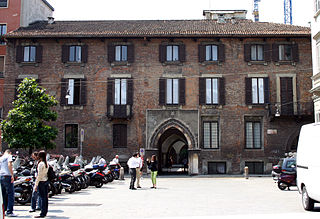
Palazzo Borromeo is a 14th-century building located at piazza Borromeo 12 in Milan, region of Lombardy, Italy. It was built as the home and business headquarters of the Borromeo family, merchant-bankers from Tuscany. Some of the building complex was badly damaged during World War II in Allied bombings of 1943 but was reconstructed and restored to its 15th-century appearance. It contains an important fresco cycle from the 1440s and is one of the finest examples of a Milanese patrician palace from the early Renaissance.

The Palazzo delle Scuole Palatine is a historic building of Milan, Italy, located in Piazza Mercanti, the former city centre in the Middle Ages. It served as the seat of the most prestigious higher school of medieval Milan. Many notable Milanese scholars of different ages studied or taught in these schools; Augustine of Hippo and Cesare Beccaria, among others, served as teachers in the Palatine. The current building dates back to 1644, when it replaced an older one, which had the same function and was destroyed by a fire.

Palazzo Mezzanotte, also known as Palazzo delle Borse is a 20th-century building of Milan, Italy, and the seat of the Italian stock exchange. It is located in Piazza Affari, the city square after which the Italian stock exchange itself is nicknamed. The name "Palazzo Mezzanotte" is a reference to Paolo Mezzanotte, the architect who designed the building.

Castello Cova, also known as Palazzo Viviani Cova is a landmark Neo-Gothic style residential and business building located on Via Giosuè Carducci #36, in central Milan, region of Lombardy, Italy. It is located some 100 meters west of the Basilica of Sant'Ambrogio. The building was designed by architect Adolfo Coppedè. Adolfo's career is also noted for designing the Casa del Fascio in Signa, and he was never shy to indulge in the appropriation of former styles and symbols; this building notable for its height and accumulation of Gothic architecture motifs such as a merlionated tower, peaked and rusticated ground-floor arches, and mullion-windows. It sports numerous decorated balconies on the facade.

Neoclassical architecture in Milan encompasses the main artistic movement from about 1750 to 1850 in this northern Italian city. From the final years of the reign of Maria Theresa of Austria, through the Napoleonic Kingdom of Italy and the European Restoration, Milan was in the forefront of a strong cultural and economic renaissance in which Neoclassicism was the dominant style, creating in Milan some of the most influential works in this style in Italy and across Europe. Notable developments include construction of the Teatro alla Scala, the restyled Royal Palace, and the Brera institutions including the Academy of Fine Arts, the Braidense Library and the Brera Astronomical Observatory. Neoclassicism also led to the development of monumental city gates, new squares and boulevards, as well as public gardens and private mansions. Latterly, two churches, San Tomaso in Terramara and San Carlo al Corso, were completed in Neoclassical style before the period came to an end in the late 1830s.

The Palazzo Brentani is a monumental Neoclassical palace, located on Via Manzoni #6, in the centre of Milan, region of Lombardy, Italy. Both this palace and the adjacent Palazzo Anguissola have sober academic facades, designed by Luigi Canonica in 1829.

The Palazzo Belgioioso is a palatial residence in the northern Italian city of Milan, completed in 1781 in a Neoclassical style by Giuseppe Piermarini.

The Palazzo Anguissola or Anguissola Traversi is a palace located at Via Manzoni number 10, in central Milan, a city in the northern Italy. Construction began in 1778, and its Neoclassical facade, designed by Luigi Canonica, was added in 1829.
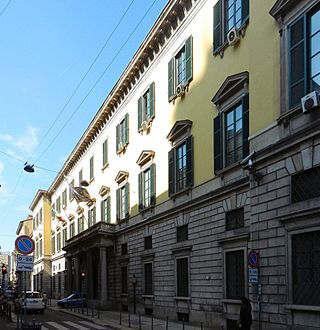
The Prefecture, Milan, also known as Palazzo Diotti, is a historic neoclassical building which has been the location of the office of the Prefect of Milan since 1859. The building is situated at 31, Corso Monforte in the city.

Art Nouveau in Milan indicates the spread of such artistic style in the city of Milan between the early years of the 20th century and the outbreak of the First World War. In the Lombard capital, art nouveau, called StileLiberty in Italian, found—thanks to its close relationship with the rampant industrial bourgeoisie of the time—a fertile ground for its rapid development, during which it oscillated between the influences of French Art Nouveau, German Jugendstil and eclecticism.

The Palazzo del Monte di Pietà is a 15th-century palazzo in Milan, Italy, adapted in a neoclassical style in the 18th century by Giuseppe Piermarini. Historically belonging to the Sestiere di Porta Nuova, it is located in Via Monte di Pietà no. 5, and was the seat of the Monte di Pietà di Milano.

The Palazzo di Prospero Visconti' is a 16th-century palace in Milan. Historically belonging to the sestiere di Porta Ticinese, it is located in via Lanzone 2, in the ancient contrada del Torchio no. 2,919.

Palazzo Isimbardi, also palazzo della Provincia, is a historic building in Milan located at 35 Corso Monforte, the seat of the Metropolitan City of Milan.
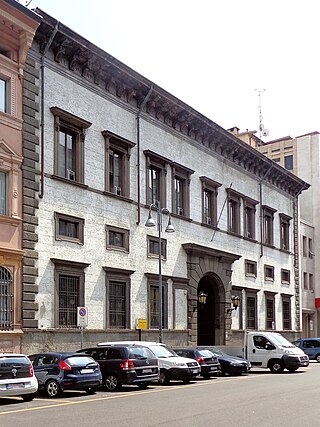
Palazzo Spinola is a 16th-century palazzo in Milan, heavily remodelled during the 19th century. Historically belonging to the sestiere di Porta Nuova, it is located at 10 Via San Paolo. Since 1808 it has been the seat of the Garden Society.

Palazzo Visconti di Grazzano, also known as Palazzo Visconti di Modrone or Palazzo Bolagnos, is a historical palace located in the centre of Milan, in Via Cino del Duca no. 8.
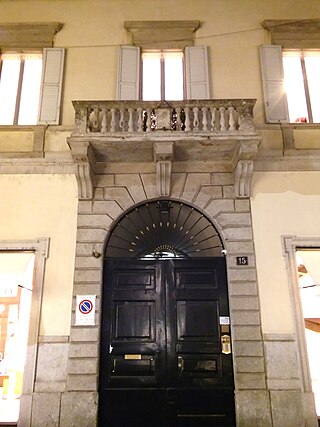
Casa Crespi is a historic building in Milan located at 15 Via Sant’Andrea.

Palazzo Acerbi is a 17th-century palace in Milan in the Baroque style. Historically belonging to the sestiere di Porta Romana, the palace is located at corso di Porta Romana no. 3.
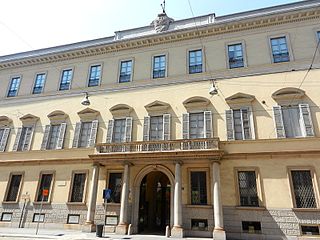
Palazzo Borromeo D’Adda, is an 18th-century palazzo in Milano. Historically belonging to the sestiere di Porta Nuova, it is located at via Manzoni no. 39/41.





















